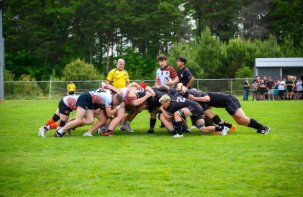America’s favorite pastime: slapping some pads on kids and letting them go out and mangle each other, right? Football has been the most popular sport in America since the 1960s, but this may be in danger in the future. For the sake of the contact sport’s future officials should make safety a priority.
There has been a noticeable decrease in kids playing football in the last ten years, as shown by several popular youth football programs. According to the New York Times, there has been nearly a 20 percent decrease in youth football participation in boys ages 6 to 12 since 2007. Even though there was a 1.2 percent increase in 2015, the last year with this information, a 20 percent drop in youth participation in America’s most popular sport is substantial.
In Chicago, several of the major youth football programs have seen noticeable declines in popularity. According to the Chicago Tribune, the Addison Trail High School youth program, which had once had more than 150 kids in one year, shut down in 2017 when only 11 kids showed up. The Chicagoland Youth Football League, a large youth football program, hosted only 7,500 kids in 2017, down from roughly 10,000 kids ten years earlier, nearly a 25 percent decrease.
If participation among youth continues to decrease, the sport will eventually lose its popularity, because kids will choose to play and watch other sports. Also, if school programs shut down due to lack of interest, kids who are still interested will not be able to play.
Flag football, a non-contact alternative for football, has seen a rise at the same time that conventional football has decreased. In 2015, flag football was the fastest growing sport among youth in the country, seeing an 8.7 percent rise in one year. Many parents of children who are switching to flag football are concerned about safety problems with football, and flag football is the safer alternative. If flag football becomes a more common alternative to conventional football, many parents will likely have their kids play it rather than football to keep them safe, and the popularity of football will decrease even more.
Obviously, the demise of football is due to safety problems. Among other risks, head injuries are the most prevalent, with a disease known as Chronic Traumatic Encephalopathy (CTE) that has been extensively studied. CTE is a degenerative brain disease common in former athletes and military veterans that causes behavioral and emotional problems. CTE was first diagnosed in a football player in 2002, and since then, there has been much research connecting football to CTE. The Annals of Neurology, a neurological medical journal, recently studied 246 deceased former professional and amateur football players. Of the 246 players, 211 had CTE.
The problem isn’t only with professional players; youth players can also experience brain trauma. According to the Boston University Chronic Traumatic Encephalopathy Center, playing football before the age of 12 can increase the odds of developing symptoms of CTE: behavioral problems, apathy, lack of executive functioning, and symptoms of depression.
Parents of athletes are beginning to encourage their children to play sports other than football, due to worries about head injuries. According to a poll by NBC, 48 percent of parents said that they would prefer their children to play a sport other than football. The same poll showed that only 33 percent of Americans believe that the National Football League (NFL) has taken meaningful action to prevent head injury through rules and regulations. Clearly, the American people believe that the NFL should be doing more to protect heads.
For the sake of the future of the sport, every football league and association needs to make safety the absolute priority. Of course, the NFL and NCAA may claim that safety is a priority, but clearly they are not doing enough.
There have been some strides in recent history to make football safer, but there still needs to be more.
The biggest advance in the prevention of head injury in football has been the advent of the targeting rule. The targeting rule is a penalty for when a player hits another player in the head forcefully or leads with the crown of the helmet in a hit. Before the penalties of the rule were increased in 2013, players would occasionally receive penalties for hits to the head, and professional players were sometimes subject to fines. Now, the rule is more strict, and players are now often ejected from games for a hit to the head of a defenseless player. This rule has also gotten more coaches to be strict with players to avoid in-game penalties.
Each year, the NFL, NCAA, and state high school athletic associations all review equipment requirements, and most years, there are new restrictions for helmets. According to the NFL, there are several specific requirements for helmets to have “advanced suspension and cushioning systems.” If helmets don’t have the necessary padding to pass NFL standards, any players with those helmets are ineligible. Compared to the minimally padded helmets of the twentieth century, these helmets do a lot to prevent head injury. However, there is always room for improvement, so football leagues often update standards to the newest technology.
It is obvious that football leagues make an effort to promote safety, but they are clearly not doing enough. As long as a relatively high percent of football players are sustaining long term brain injuries and parents don’t trust the safety of the sport, much more needs to be done to create safety for the sport. Safety can be better achieved, and it must be for the future of the sport.
For other contact sports, such as rugby and hockey, the same needs to happen. The only reason that this isn’t as much as a problem for other contact sports is a lack of research. Football is by far the most popular sport to watch in America, so it is bound to have by far the most research. And with the research around football, there is a very common conclusion that the sport often causes permanent brain damage. However, contact sports that don’t receive as much attention will not get the same amount of research. Any sport where players are constantly taking heavy hits will likely cause some sort of brain damage, even if it is not as bad as football.
However, for now, other contact sports will not lose popularity because of safety reasons. In fact, rugby is one of the fastest growing sports in America, a sport with just as much contact as football but with fewer pads. But, eventually, there will be a link between other contact sports and brain injuries such as CTE; more research is needed. Once the research is available, parents will have a distrust for all contact sports just as they do for football.
For the future of contact sports, safety must be a priority, even more than it currently is. If not, the future of contact sports may be dim, because parents will push their kids to play other sports.







